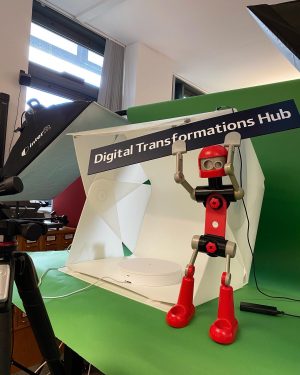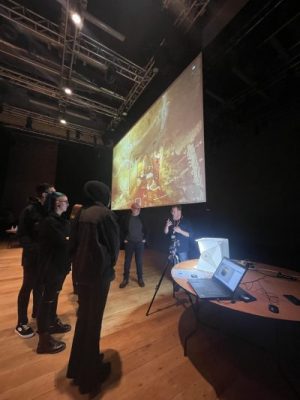January 16, 2023, by Matt Davies
DTH Update: Spring term 2023
2022-2023 got off to a very busy start in DTH with a new member of staff, team of student volunteers and projects as well as some old favourites – projects, not staff members!
Research Associates
In October we were very pleased to welcome new DTH RA Xiangzhen ‘Cherry’ He to the team. Cherry is a second year PhD student in the English department and has been covering DTH on Wednesdays when, besides the usual RA duties such as looking after visitors and equipment loans, she supervises volunteers working on the Hennessy digitisation project (details below). She joins our other RA Abigail Parker, who is in her second year working in the DTH where she can be found on Fridays running the Marketing project.
Student volunteers
In October we started a new team of twenty-five student volunteers drawn from across the Faculty of Arts. All completed a Moodle course and on-site training so are fully competent to help visiting FoA staff and students with creating or editing digital content for studies, research, or teaching. At the start of the academic year, they attended our annual DTH Project Pitch event at which they listened carefully to project leaders and then chose one of five real world digital projects to work on.
Visit our webpages to find out more about the Research Associates and the Student Volunteers.
The Projects
The Nottingham Alabaster project
Following a successful bid for IAA funding the English department’s Dr Joanna Martin and Dr Kate Kim-Mclean along with the DTH team are working with curators from Nottingham Museums and Galleries to create online resources for the city’s internationally significant collection of medieval Alabasters. Housed in the Early Craft Gallery at Nottingham Castle, the Alabasters are a collection of internationally significant sculptures depicting the Virgin and child, St Zita, St Peter, and scenes from the life of Christ. The online resources will include videos and digital recordings of medieval prayers and poems read by the team in middle English – and in a variety of accents!
The University of Nottingham 3D Photogrammetry project
This year’s team have learnt the complex 3D photogrammetry (see here for details) process incredibly quickly and have already created photo-realistic 3D models of several artefacts from the University Museum. These include a medieval pottery jug from Chapel Caves in Nottingham which has been particularly relevant as, in November the DTH was asked to demonstrate the 3D photogrammetry workflow at Nottingham Contemporary Art Gallery as part of the Being Human festival. It was a great experience which we are very excited to be repeating this week at the Contemporary’s What Lies Beneath: Immersive Technologies Event which is part of the gallery’s closing week for its Hollow Earth: Art, Caves & The Subterranean Imaginary exhibition.
The DTH Marketing project
In her second year running the project Abigail has found herself in charge of a team of students who are keen video makers and have also been having great fun utilising new DTH equipment to create 360° videos. DTH mascot Digital Dan has certainly been getting about and will apparently be joined by a new mascot in January. You can keep up with the adventures of Digital Dan, the volunteers and the new mystery mascot by following DTH on TikTok, Instagram, Twitter and Facebook.
You can find links to all of the DTH’s Social media feeds on our Student Involvement webpage.
The Hennessy Collection digitisation project
New RA Cherry took on one of the tougher projects when she agreed to supervise the Hennessy digitisation project which has been running for a few years now. Students working on it are trained how to use the copystand and DSLR camera to capture the University’s unique collection of 1960s Cuban newspapers to professional archive standards. The complex workflow, taught to the students by Manuscripts and Special Collections digitisation officer Mark Bentley, includes setting up, lighting, capture, post process using photoshop and metadata capture and upload.
Archaeology Slide Digitisation project
Similarly the Archaeology slide digitisation project requires its student volunteers to learn complex and unique digital skills. These, along with the ‘soft’ skills (teamwork, organisation, time management etc) and the hours of work experience they are gaining, make their CVs really stand out. The 35mm slide collection dates back to the 1950s and is the only record in existence of the digs, sites and finds of the department.
You can find more details on both the Hennessy and Archaeology Slide digital archiving projects on previous Digital Dialogies posts.
No comments yet, fill out a comment to be the first



Leave a Reply